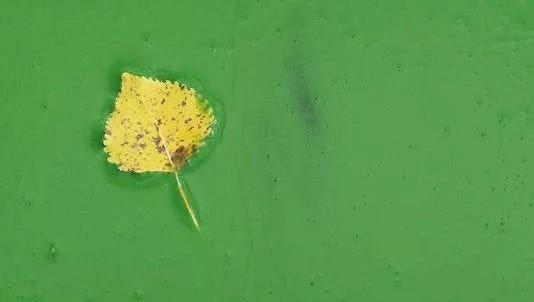Which 8 Lakes in Indiana Have Blue Green Algae
After the deaths of three dogs that came in contact with toxic blue-green algae in a North Carolina pond, Indiana health officials are warning Hoosiers of possible high levels of algae in many bodies of water in the state.
On Friday, the Indiana Department of Environmental Management said sampling revealed high levels of blue-green algae in nine different locations. The water sampling began May 13 and will continue through the week of Aug. 26.
Here's where the algae could cause problems, how to identify it and how Hoosiers can stay safe should they encounter it.

Active blue-green algae alerts in Indiana
According to the Indiana Department of Natural Resources, blue-green algae alerts are issued at four levels. "Low-risk" means you shouldn't drink the water and you should shower after you swim.
"Advisory" means swimming and boating is permitted, but people should avoid contact with algae. Avoid swallowing water while swimming, and take a bath or shower with warm, soapy water after being in the water. Do not use lake water for cooking or bathing, and do not allow your pets to swim or drink water where algae are present.
"Caution" carries all the same warnings as the "advisory" level with the addition that children and others with compromised immune systems should not swim.
"Closed" means the algae and toxin level make the area unsafe for swimming.
As of Thursday afternoon, the following locations were under an "advisory" alert:
- Brookville Lake — Quakertown State Recreational Area
- Brookville Lake — Mounds SRA
- Cecil M Harden Lake — Raccoon Lake SRA
- Hardy Lake — Hardy Lake SRA
- Kunkel Lake — Ouabache SP
- Mississinewa Lake — Mississinewa Miami SRA
- Monroe Lake — Fairfax SRA
- Monroe Lake — Paynetown SRA
- Whitewater Lake — Whitewater Memorial SP
- Worster Lake — Potato Creek State Park
An interactive blue-green algae map from the State Department of Health showed "low" alerts for Lake James in Pokagon State Park Inn; Sand Lake in Chain O'Lakes State Park; Salamonie Lake in Salamonie Lost Bridge West SRA; Starve Hollow Lake in Starve Hollow SRA; and Deam Lake in Deam Lake SRA.
"Swimmers and boaters should be careful in all recreational waters during this time of the year," a statement from the Indiana Department of Environmental Management said. "Exposure to blue-green algae during recreational activities such as swimming, wading and water-skiing may lead to rashes, skin, eye irritation and other uncomfortable effects such as nausea, stomach aches and tingling in fingers and toes.
"If you should experience any symptoms after water recreational activities, please contact your doctor."
Officials said dogs are particularly susceptible to blue-green algae poisoning because the scum can attach to their coats and be swallowed during self-cleaning.
Clinical signs of blue-green algae poisoning in animals include vomiting, diarrhea, decreased appetite, weakness, seizures and sudden death.
How to identify blue-green algae
According to the Indiana DNR, blue-green algae are a group of photosynthetic bacteria that are most often blue-green in color. They can also be blue, green, reddish-purple or brown.
"When environmental conditions are just right, they can multiply quickly," a DNR statement said. "Most species rise to the surface where they form floating mats but some stay suspended under the water's surface."
The nutrients that cause an algae "bloom" come from excess or misapplied lawn and agricultural fertilizers, runoff from pastures, feedlots, lawns and golf courses, discharges from non-regulated sewage treatment systems and many other sources of organic nutrients, according to the DNR.
Other factors include sunlight, warm weather and low turbulence. IDEM warns that algal blooms are most common from May to October but can happen year-round.
Blue-green algae can appear in a variety of forms, officials said. They can look like film, crust or puff balls at the surface. They also may look like grass clippings or dots in the water.
Some algae blooms look like spilled paint, pea soup, foam, wool, streaks or green cottage cheese curd.
High algae leaves do not impact the state's drinking water, officials said.
What do I do if my dog comes in contact with algae?
If pets swim in scummy water, immediately rinse them off with soap and water to remove the toxin, officials said. Do not let them lick the algae from their fur.
Livestock should be directed to water sources away from algal-infected waters. If your animal shows any of the clinical signs, contact your veterinarian immediately.
Call IndyStar reporter Justin L. Mack at 317-444-6138. Follow him on Twitter: @justinlmack.
Source: https://www.indystar.com/story/news/local/indianapolis/2019/08/13/toxic-algae-indiana-what-you-need-know-blue-green-algae/1995807001/
0 Response to "Which 8 Lakes in Indiana Have Blue Green Algae"
Enviar um comentário